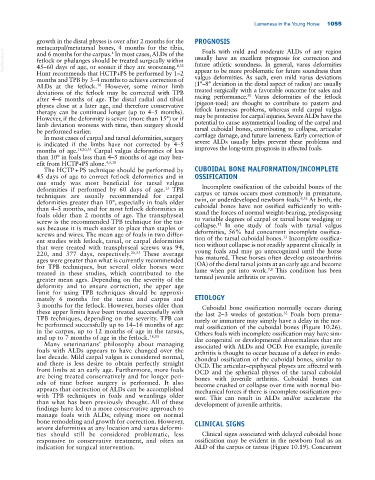Page 1089 - Adams and Stashak's Lameness in Horses, 7th Edition
P. 1089
Lameness in the Young Horse 1055
growth in the distal physes is over after 2 months for the PROGNOSIS
metacarpal/metatarsal bones, 4 months for the tibia, Foals with mild and moderate ALDs of any region
VetBooks.ir fetlock or phalanges should be treated surgically within usually have an excellent prognosis for correction and
and 6 months for the carpus. In most cases, ALDs of the
4
future athletic soundness. In general, varus deformities
45–60 days of age, or sooner if they are worsening.
4,32
Hunt recommends that HCTP+PS be performed by 1–2 appear to be more problematic for future soundness than
months and TPB by 3–4 months to achieve correction of valgus deformities. As such, even mild varus deviations
18
ALDs at the fetlock. However, some minor limb (1°–8° deviation in the distal aspect of radius) are usually
deviations of the fetlock may be corrected with TPB treated surgically with a favorable outcome for sales and
30
after 4–6 months of age. The distal radial and tibial racing performance. Varus deformities of the fetlock
physes close at a later age, and therefore conservative (pigeon‐toed) are thought to contribute to pastern and
therapy can be continued longer (up to 4–5 months). fetlock lameness problems, whereas mild carpal valgus
However, if the deformity is severe (more than 15°) or if may be protective for carpal injuries. Severe ALDs have the
limb deviation worsens with time, then surgery should potential to cause asymmetrical loading of the carpal and
be performed earlier. tarsal cuboidal bones, contributing to collapse, articular
In most cases of carpal and tarsal deformities, surgery cartilage damage, and future lameness. Early correction of
is indicated if the limbs have not corrected by 4–5 severe ALDs usually helps prevent these problems and
months of age. 18,20,33 Carpal valgus deformities of less improves the long‐term prognosis in affected foals.
than 10° in foals less than 4–5 months of age may ben
efit from HCTP+PS alone. 4,5,18
The HCTP + PS technique should be performed by CUBOIDAL BONE MALFORMATION/INCOMPLETE
45 days of age to correct fetlock deformities and in OSSIFICATION
one study was most beneficial for tarsal valgus
deformities if performed by 60 days of age. TPB Incomplete ossification of the cuboidal bones of the
13
techniques are usually recommended for carpal carpus or tarsus occurs most commonly in premature,
6,32
deformities greater than 10°, especially in foals older twin, or underdeveloped newborn foals. At birth, the
than 4–5 months, and for most fetlock deformities in cuboidal bones have not ossified sufficiently to with
foals older than 2 months of age. The transphyseal stand the forces of normal weight‐bearing, predisposing
screw is the recommended TPB technique for the tar to variable degrees of carpal or tarsal bone wedging or
12
sus because it is much easier to place than staples or collapse. In one study of foals with tarsal valgus
screws and wires. The mean age of foals in two differ deformities, 56% had concurrent incomplete ossifica
13
ent studies with fetlock, tarsal, or carpal deformities tion of the tarsal cuboidal bones. Incomplete ossifica
that were treated with transphyseal screws was 94, tion without collapse is not readily apparent clinically in
220, and 377 days, respectively. 20,33 These average young foals and may go unrecognized until the horse
ages were greater than what is currently recommended has matured. These horses often develop osteoarthritis
for TPB techniques, but several older horses were (OA) of the distal tarsal joints at an early age and become
7,8
treated in these studies, which contributed to the lame when put into work. This condition has been
greater mean ages. Depending on the severity of the termed juvenile arthritis or spavin.
deformity and to ensure correction, the upper age
limit for using TPB techniques should be approxi
mately 6 months for the tarsus and carpus and ETIOLOGY
3 months for the fetlock. However, horses older than Cuboidal bone ossification normally occurs during
these upper limits have been treated successfully with the last 2–3 weeks of gestation. Foals born prema
32
TPB techniques, depending on the severity. TPB can turely or immature may simply have a delay in the nor
be performed successfully up to 14–16 months of age mal ossification of the cuboidal bones (Figure 10.26).
in the carpus, up to 12 months of age in the tarsus, Others foals with incomplete ossification may have sim
and up to 7 months of age in the fetlock. 18,33 ilar congenital or developmental abnormalities that are
Many veterinarians’ philosophy about managing associated with ALDs and OCD. For example, juvenile
foals with ALDs appears to have changed over the arthritis is thought to occur because of a defect in endo
last decade. Mild carpal valgus is considered normal, chondral ossification of the cuboidal bones, similar to
and there is less desire to obtain perfectly straight OCD. The articular–epiphyseal physes are affected with
front limbs at an early age. Furthermore, more foals OCD and the spherical physes of the tarsal cuboidal
are being treated conservatively and for longer peri bones with juvenile arthritis. Cuboidal bones can
ods of time before surgery is performed. It also become crushed or collapse over time with normal bio
appears that correction of ALDs can be accomplished mechanical forces if there is incomplete ossification pre
with TPB techniques in foals and weanlings older sent. This can result in ALDs and/or accelerate the
than what has been previously thought. All of these development of juvenile arthritis.
findings have led to a more conservative approach to
manage foals with ALDs, relying more on normal
bone remodeling and growth for correction. However, CLINICAL SIGNS
severe deformities at any location and varus deformi
ties should still be considered problematic, less Clinical signs associated with delayed cuboidal bone
responsive to conservative treatment, and often an ossification may be evident in the newborn foal as an
indication for surgical intervention. ALD of the carpus or tarsus (Figure 10.19). Concurrent

